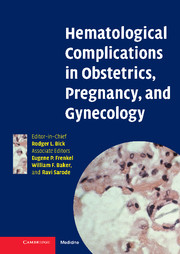Book contents
- Frontmatter
- Contents
- List of contributors
- Preface
- 1 Disseminated intravascular coagulation in obstetrics, pregnancy, and gynecology: Criteria for diagnosis and management
- 2 Recurrent miscarriage syndrome and infertility caused by blood coagulation protein/platelet defects
- 3 Von Willebrand disease and other bleeding disorders in obstetrics
- 4 Hemolytic disease of the fetus and newborn caused by ABO, Rhesus, and other blood group alloantibodies
- 5 Hereditary and acquired thrombophilia in pregnancy
- 6 Thromboprophylaxis and treatment of thrombosis in pregnancy
- 7 Diagnosis of deep vein thrombosis and pulmonary embolism in pregnancy
- 8 Hemorrhagic and thrombotic lesions of the placenta
- 9 Iron deficiency, folate, and vitamin B12 deficiency in pregnancy, obstetrics, and gynecology
- 10 Thrombosis prophylaxis and risk factors for thrombosis in gynecologic oncology
- 11 Low molecular weight heparins in pregnancy
- 12 Post partum hemorrhage: Prevention, diagnosis, and management
- 13 Hemoglobinopathies in pregnancy
- 14 Genetic counseling and prenatal diagnosis
- 15 Thrombocytopenia in pregnancy
- 16 Neonatal immune thrombocytopenias
- 17 The rational use of blood and its components in obstetrical and gynecological bleeding complications
- 18 Heparin-induced thrombocytopenia in pregnancy
- 19 Coagulation defects as a cause for menstrual disorders
- Index
- Plate section
- References
16 - Neonatal immune thrombocytopenias
Published online by Cambridge University Press: 01 February 2010
- Frontmatter
- Contents
- List of contributors
- Preface
- 1 Disseminated intravascular coagulation in obstetrics, pregnancy, and gynecology: Criteria for diagnosis and management
- 2 Recurrent miscarriage syndrome and infertility caused by blood coagulation protein/platelet defects
- 3 Von Willebrand disease and other bleeding disorders in obstetrics
- 4 Hemolytic disease of the fetus and newborn caused by ABO, Rhesus, and other blood group alloantibodies
- 5 Hereditary and acquired thrombophilia in pregnancy
- 6 Thromboprophylaxis and treatment of thrombosis in pregnancy
- 7 Diagnosis of deep vein thrombosis and pulmonary embolism in pregnancy
- 8 Hemorrhagic and thrombotic lesions of the placenta
- 9 Iron deficiency, folate, and vitamin B12 deficiency in pregnancy, obstetrics, and gynecology
- 10 Thrombosis prophylaxis and risk factors for thrombosis in gynecologic oncology
- 11 Low molecular weight heparins in pregnancy
- 12 Post partum hemorrhage: Prevention, diagnosis, and management
- 13 Hemoglobinopathies in pregnancy
- 14 Genetic counseling and prenatal diagnosis
- 15 Thrombocytopenia in pregnancy
- 16 Neonatal immune thrombocytopenias
- 17 The rational use of blood and its components in obstetrical and gynecological bleeding complications
- 18 Heparin-induced thrombocytopenia in pregnancy
- 19 Coagulation defects as a cause for menstrual disorders
- Index
- Plate section
- References
Summary
Introduction
Platelets first appear in the fetal circulation at approximately 5–6 weeks of gestational age. By the end of the first trimester, the mean fetal platelet count is greater than 150 × 109/l and this is maintained for the remainder of the gestation. Thus, at birth full term infants have normal platelet counts.
Thrombocytopenia in the full term, healthy neonate is defined as a platelet count of less than 150 × 109/l. The frequency of neonatal thrombocytopenia has been estimated at 1–4%. Approximately 1–2% of term infants born to mothers with normal platelet counts are thrombocytopenic at birth. There are numerous causes of neonatal thrombocytopenia, and a severe form of the disorder may result from increased consumption or destruction, deficient production, or abnormal splenic sequestration of platelets.
The major causes of neonatal thrombocytopenia are non-immune and related to infection, sepsis etc. Immune mediated platelet destruction resulting from transplacental passage of maternal antibodies remains an important cause of thrombocytopenia at birth. Up to 15% of neonatal thrombocytopenias that occur at birth result from maternal auto- or alloantibodies directed against fetal platelet antigens. Neonatal thrombocytopenia can be a devastating clinical condition and requires systematic evaluation of the cause and its management. It is also important to address the possibility of recurrence of thrombocytopenia in subsequent pregnancies. This chapter focuses on immune mediated thrombocytopenia in the fetus and neonate.
Neonatal alloimmune thrombocytopenia (NAITP)
Overview
NAITP is defined as thrombocytopenia (platelet count < 150 × 109/l) due to transplacentally acquired maternal platelet alloantibodies.
- Type
- Chapter
- Information
- Publisher: Cambridge University PressPrint publication year: 2006



